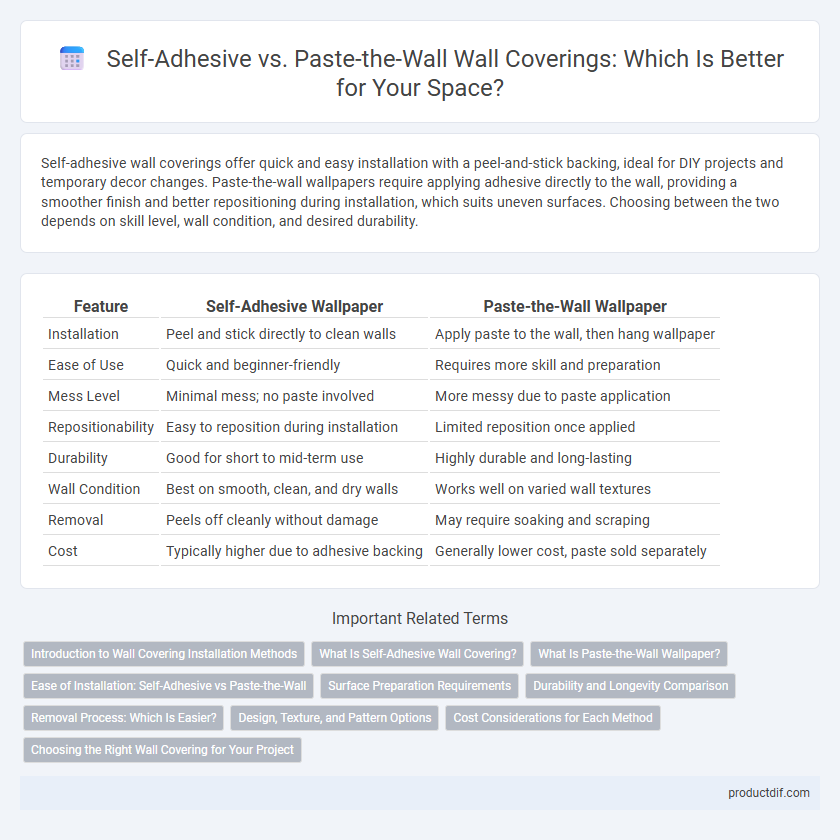Self-adhesive wall coverings offer quick and easy installation with a peel-and-stick backing, ideal for DIY projects and temporary decor changes. Paste-the-wall wallpapers require applying adhesive directly to the wall, providing a smoother finish and better repositioning during installation, which suits uneven surfaces. Choosing between the two depends on skill level, wall condition, and desired durability.
Table of Comparison
| Feature | Self-Adhesive Wallpaper | Paste-the-Wall Wallpaper |
|---|---|---|
| Installation | Peel and stick directly to clean walls | Apply paste to the wall, then hang wallpaper |
| Ease of Use | Quick and beginner-friendly | Requires more skill and preparation |
| Mess Level | Minimal mess; no paste involved | More messy due to paste application |
| Repositionability | Easy to reposition during installation | Limited reposition once applied |
| Durability | Good for short to mid-term use | Highly durable and long-lasting |
| Wall Condition | Best on smooth, clean, and dry walls | Works well on varied wall textures |
| Removal | Peels off cleanly without damage | May require soaking and scraping |
| Cost | Typically higher due to adhesive backing | Generally lower cost, paste sold separately |
Introduction to Wall Covering Installation Methods
Self-adhesive wall coverings offer a convenient peel-and-stick application, making them ideal for DIY projects with minimal mess and faster installation. Paste-the-wall wallpapers require applying adhesive directly to the wall, providing better alignment and repositioning during installation, often preferred for traditional paper or fabric wall coverings. Choosing between these methods depends on wallpaper material, surface type, and desired ease of application.
What Is Self-Adhesive Wall Covering?
Self-adhesive wall coverings feature a peel-and-stick backing that eliminates the need for paste, enabling quick and clean installation. These wallpapers offer convenience, reduced mess, and easy repositioning, making them ideal for DIY projects and temporary decor updates. Their adhesive technology ensures strong bonding to smooth surfaces while allowing removal without damaging walls.
What Is Paste-the-Wall Wallpaper?
Paste-the-wall wallpaper is a type of wall covering where the adhesive paste is applied directly to the wall rather than the wallpaper itself, making installation cleaner and easier. This method reduces waiting time for soaking and limits the risk of damaging the paper during application, ideal for textured or delicate wallpapers. It offers a more user-friendly alternative to traditional self-adhesive wallpapers, which come pre-coated with adhesive for quick peel-and-stick installation.
Ease of Installation: Self-Adhesive vs Paste-the-Wall
Self-adhesive wall coverings offer superior ease of installation due to their pre-applied adhesive backing, eliminating the need for messy paste and reducing preparation time. Paste-the-wall wallpapers require applying adhesive directly to the wall, which can be less forgiving and more time-consuming, often demanding precise alignment and drying time. For DIY enthusiasts, self-adhesive options provide a cleaner, faster, and more straightforward application process, making them ideal for quick renovations.
Surface Preparation Requirements
Self-adhesive wall coverings require a clean, smooth, and dry surface free from dust, grease, and loose particles to ensure proper adhesion and durability. Paste-the-wall wallpapers need primed or sealed surfaces to prevent moisture absorption and allow easy repositioning during installation without compromising the wallpaper's integrity. Proper surface preparation for each type enhances longevity and prevents issues such as peeling, bubbling, or misalignment.
Durability and Longevity Comparison
Self-adhesive wall coverings typically offer moderate durability, as their adhesive can weaken over time due to humidity and temperature changes, limiting their longevity. Paste-the-wall wallpapers, however, often provide superior durability because the paste creates a stronger, more resilient bond with the wall surface, resulting in longer-lasting adhesion. For high-traffic or moisture-prone areas, paste-the-wall options are generally preferred for extended lifespan and better resistance to peeling.
Removal Process: Which Is Easier?
Self-adhesive wall coverings are generally easier to remove as they peel off cleanly without leaving residue or damaging the wall surface, making them ideal for temporary or rental spaces. Paste-the-wall wallpapers require soaking and careful scraping to soften the adhesive, which can lead to more wall damage and longer cleanup times. The ease of removal for self-adhesive options reduces labor and repair costs compared to traditional paste-the-wall materials.
Design, Texture, and Pattern Options
Self-adhesive wall coverings offer a wide range of modern designs with smooth textures, ideal for quick application and removal, while paste-the-wall options provide traditional, richly textured surfaces that enhance intricate patterns. Paste-the-wall wallpapers accommodate complex, detailed patterns with superior durability, making them suitable for classic and historical interior styles. The choice between self-adhesive and paste-the-wall depends on design goals, with self-adhesive favoring contemporary aesthetics and paste-the-wall excelling in textured, patterned finishes.
Cost Considerations for Each Method
Self-adhesive wall coverings typically have a higher upfront cost due to the pre-applied adhesive but save money on installation labor and materials, making them ideal for DIY projects and smaller budgets. Paste-the-wall wallpaper requires purchasing separate paste and often professional installation, increasing overall expenses, but it allows for easier repositioning and adjustment during application, potentially reducing waste. Evaluating total costs should include material price, installation complexity, and potential need for professional services to determine the most cost-effective choice for a project.
Choosing the Right Wall Covering for Your Project
Self-adhesive wall coverings offer easy installation and repositioning, making them ideal for small projects and temporary designs, while paste-the-wall wallpapers provide stronger adhesion and durability suited for larger, long-term applications. Consider surface type, project scale, and skill level when deciding; self-adhesive is better for smooth, clean walls, whereas paste-the-wall works well on more textured surfaces. Selecting the right wall covering ensures a professional finish, saves time, and minimizes waste during your renovation or decorating project.
Self-adhesive vs Paste-the-wall Infographic

 productdif.com
productdif.com